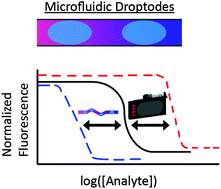Characterization of the impact of mixing and droplet volumes on the behavior of microfluidic ion-selective droptodes†
Abstract
Droplet microfluidic optodes, or “droptodes”, have emerged as a powerful technology for rapid detection of small ions in complex matrices. While using segmented aqueous phases provides the benefits of sample isolation, the influence of the liquid nature of the oil carrier phase has not yet been explored. In this paper, we examine the influence of microfluidic parameters on droptode efficiency, using potassium-sensitive droptodes as a model system. We found that while changing flow rates on device does not change droptode performance, both channel geometry and droplet size significantly impact droptode efficiency. Specifically, enhanced mixing of the droplets leads to faster equilibration on device and lowers limits of detection by about one order of magnitude. We also found that increasing the size of the sample droplet, at the expense of the size of the oil carrier/sensing phase, leads to higher sensitivity in the linear region of the droptode. These easily manipulated properties will allow one device to potentially be adapted for several different applications, based upon the type and concentration range of measurement required.



 Please wait while we load your content...
Please wait while we load your content...